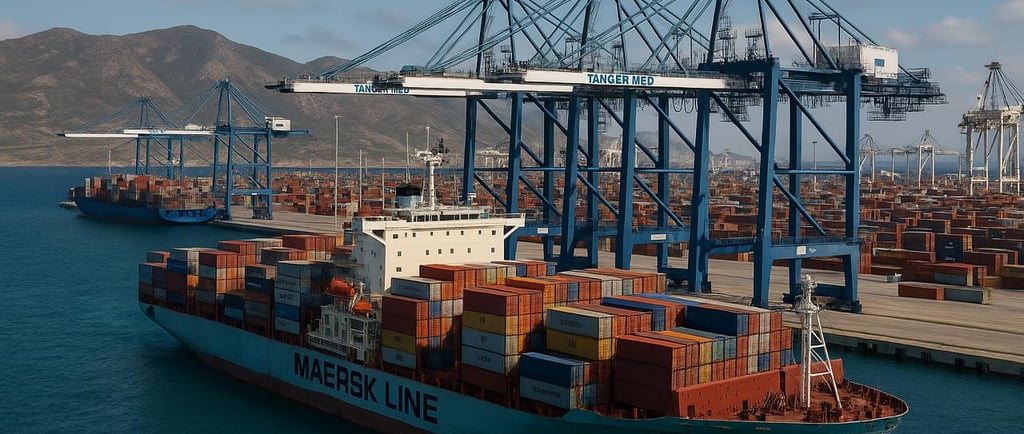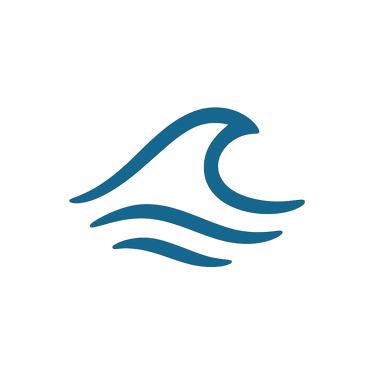Tanger Med: the Moroccan port that shakes up the global maritime hierarchy
AFRICA
Thomas Dos Remedios
7/30/20254 min read


A LOGISTIC THAT HAS BECOME A STRATEGIC SHOWCASE
In the extreme north of Morocco, on the banks of the Strait of Gibraltar, the port complex of Tanger Med has established itself in less than two decades as one of the most dynamic logistics platforms in the world. What was just a titanic project in 2003 has become, since 2023, the leading port in the Mediterranean and Africa in terms of container volume, with 9.5 million TEUs (twenty-foot equivalent units) processed in a single year, surpassing historical giants like Barcelona or Le Havre.
This success is not only based on the geographical advantage of the site – 14 kilometers from Spain and at the intersection of maritime routes between Asia, Europe and the Americas – but on a controlled development strategy, directly driven by the State. Unlike many African ports managed in fragmented concessions, Tanger Med was designed as an integrated project, articulating three key elements: a world-class transhipment port, an industrial free zone and logistics of more than 2,000 hectares, and interconnected transport infrastructure at the national level (highways, rail, gas pipelines, telecommunications).
Led by the Tanger Med Port Authority, the public arm of the State, the project benefits from a centralized governance that has made it possible to reconcile political vision, technical planning and speed of execution. In 2023, more than 1,100 companies are installed on the platform, including world leaders like Renault, Bosch, Adidas, or Huawei. The whole generated a turnover of 1.74 billion dirhams, while creating more than 110,000 direct and indirect jobs, according to figures from the TMPA.
INTEGRATION INTO GLOBAL FLOWS AND VALUE CHAINS
Tanger Med is not just a transit port: it is a real global logistics node, inserted in the major industrial value chains. The most emblematic example is that of the automotive sector. The Renault plant in Melloussa, located 30 kilometers from the port, exports more than 95% of its vehicles to Europe via Tanger Med, with a pace of 350,000 cars per year. This integration between industrial production and port logistics allows Morocco to be included in the 'just-in-time' supplier mapping for the European market.
The port also functions as a transhipment hub for the world’s leading shipping companies. The Danish group Maersk, the Italian-Swiss MSC and the Chinese COSCO have ultramodern terminals there, sometimes fully automated. Thanks to these partnerships, Tanger Med is connected to more than 180 ports in 77 countries, with about thirty weekly stopovers towards Europe, Asia and North America. The port positions itself as a reliable alternative to the congested ports of Northern Europe, while benefiting from a skilled workforce and competitive logistics costs.
According to economist Mehdi Lahlou, a specialist in maritime logistics in Africa, "Tanger Med has nothing to envy from the hubs of the Gulf or Southeast Asia. What distinguishes it is the territorial coherence of the project and the speed of its rise to power. Morocco has thus become a pivotal logistics player in Eurafrican and Eurasian flows, capable of absorbing an increasing part of intercontinental trade.
AN INSTRUMENT OF GEOPOLITICAL AND CONTINENTAL INFLUENCE
Beyond economic performance, Tanger Med is a tool for diplomatic and geo-economic influence. In a context of regional rivalry, notably with Algeria, the port strengthens Morocco’s position as a structuring maritime power. While the Algerian project for a deep-water port at Cherchell has stalled, the Kingdom is capturing a growing share of flows from Asia and West Africa for its benefit, and becomes an essential relay for shipping companies seeking to avoid regional political or logistical uncertainties.
The port is also a pivot of Morocco’s African strategy. Since the 2010s, Rabat has strengthened its trade and diplomatic relations with sub-Saharan Africa, particularly West Africa. Tanger Med acts here as a logistical bridgehead, with regular connections to Dakar, Abidjan, Lagos or Conakry. This integration is accompanied by an offensive in other sectors (banking, telecommunications, energy) which makes Morocco a key player in the emergence of Africa.
On a global scale, the port fits into the maritime silk roads promoted by China. Since the arrival of the COSCO group in 2018, Tanger Med has become a strategic gateway for Sino-European flows. This integration reinforces the multi-factor diplomacy of Morocco, which balances its partnerships between Europe, China, the Gulf and the United States, by enhancing its role as a logistics and industrial interface.
But this success is also political. For the Moroccan monarchy, Tanger Med is a showcase of stability and modernity, which serves to reinforce the image of an emerging country, organized and strategically positioned. King Mohammed VI regularly mentions it in his speeches, as a symbol of success and strategic orientation towards the future. The port has become a pillar of monarchical storytelling, mobilized to demonstrate the the ability of the regime to create wealth, to integrate into globalization and to shine in Africa.
VULNERABILITIES, LIMITS AND READJUSTMENTS
Despite its performance, the Tanger Med model presents weaknesses. First, its dependence on transhipment activity (which represents about 85% of its containerized traffic) makes the port sensitive to disruptions in global flows. The COVID-19 pandemic, tensions in the Red Sea or fluctuations in the Chinese economy remind us how vulnerable port hubs are to exogenous crises. The dominant presence of foreign shipowners also raises questions of logistical sovereignty: Morocco, to date, does not have a significant commercial fleet, nor a competitive national maritime flag.
Moreover, the territorial benefits of the port remain unequal. While Tanger Med has created jobs and stimulated certain industrial sectors, the Rif region, close to the port, remains marked by unemployment, inequalities and social tensions. The port functions largely as a logistical enclave, with little connection to the informal or artisanal economic fabric of the Moroccan north. Local associations also denounce the deteriorated working conditions in certain subcontracted sectors, notably in textiles and light logistics, where social rights are poorly respected.
Finally, the strategic issue of maritime development in Morocco remains open. Tanger Med is a central project, but it must now be part of a broader maritime sovereignty strategy. The launch of the future port of Dakhla Atlantic, planned for 2028 in the region of Western Sahara, goes in this direction: it is about opening a new axis of connectivity towards West Atlantic Africa, while strengthening the territorial integration of the Sahara. This project, eminently political, could broaden the maritime horizon of the Kingdom, provided it ensures economic viability and diplomatic acceptability.
Thomas Dos Remedios, for SPECTIO
The statements made are solely those of their authors and do not reflect the position of the Think Tank Spectio.
